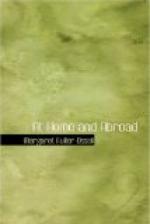Among the sculptors I delayed longest in the work-rooms of Gott. I found his groups of young figures connected with animals very refreshing after the grander attempts of the present time. They seem real growths of his habitual mind,—fruits of Nature, full of joy and freedom. His spaniels and other frisky poppets would please Apollo far better than most of the marble nymphs and muses of the present day.
Our Crawford has just finished a bust of Mrs. Crawford, which is extremely beautiful, full of grace and innocent sweetness. All its accessaries are charming,—the wreaths, the arrangement of drapery, the stuff of which the robe is made. I hope it will be much seen on its arrival in New York. He has also an Herodias in the clay, which is individual in expression, and the figure of distinguished elegance. I liked the designs of Crawford better than those of Gibson, who is estimated as highest in the profession now.
Among the studios of the European painters I have visited only that of Overbeck. It is well known in the United States what his pictures are. I have much to say at a more favorable time of what they represented to me. He himself looks as if he had just stepped out of one of them,—a lay monk, with a pious eye and habitual morality of thought which limits every gesture.
Painting is not largely represented here by American artists at present. Terry has two pleasing pictures on the easel: one is a costume picture of Italian life, such as I saw it myself, enchanted beyond my hopes, on coming to Naples on a day of grand festival in honor of Santa Agatha. Cranch sends soon to America a picture of the Campagna, such as I saw it on my first entrance into Rome, all light and calmness; Hicks, a charming half-length of an Italian girl, holding a mandolin: it will be sure to please. His pictures are full of life, and give the promise of some real achievement in Art.
Of the fragments of the great time, I have now seen nearly all that are treasured up here: I have, however, as yet nothing of consequence to say of them. I find that others have often given good hints as to how they look; and as to what they are, it can only be known by approximating to the state of soul out of which they grew. They should not be described, but reproduced. They are many and precious, yet is there not so much of high excellence as I had expected: they will not float the heart on a boundless sea of feeling, like the starry night on our Western prairies. Yet I love much to see the galleries of marbles, even when there are not many separately admirable, amid the cypresses and ilexes of Roman villas; and a picture that is good at all looks very good in one of these old palaces.
The Italian painters whom I have learned most to appreciate, since I came abroad, are Domenichino and Titian. Of others one may learn something by copies and engravings: but not of these. The portraits of Titian look upon me from the walls things new and strange. They are portraits of men such as I have not known. In his picture, absurdly called Sacred and Profane Love, in the Borghese Palace, one of the figures has developed my powers of gazing to an extent unknown before.




